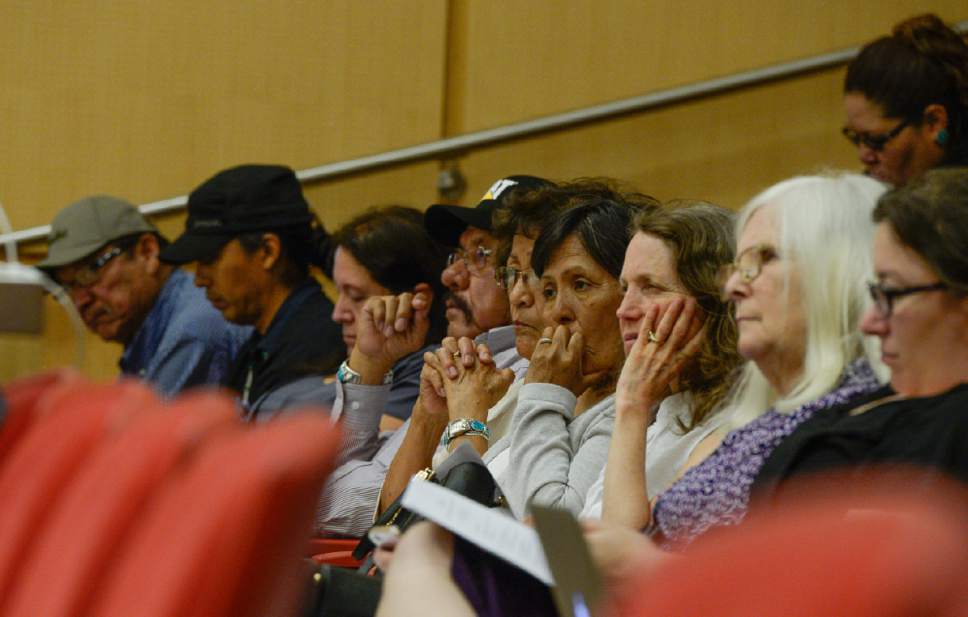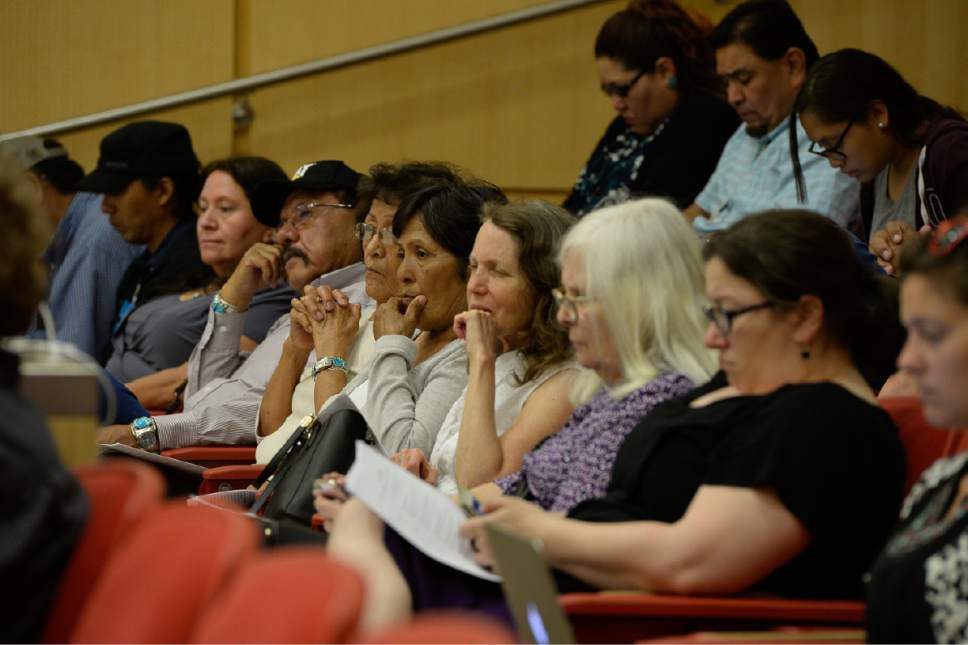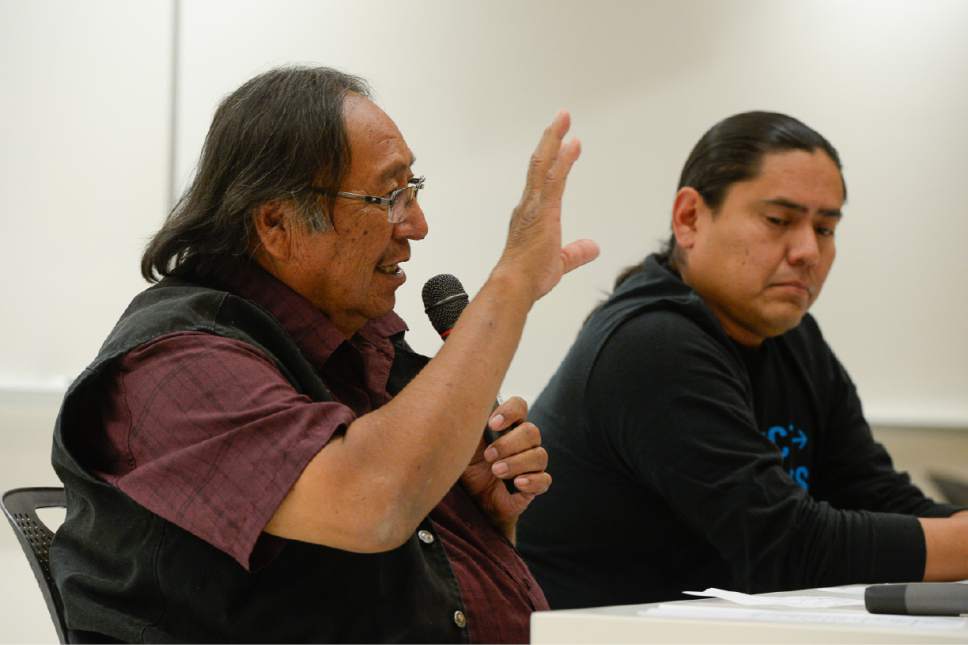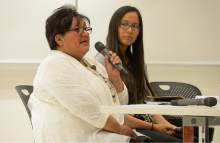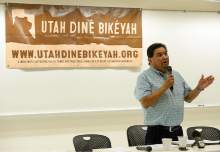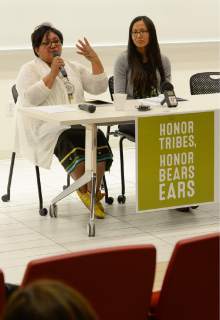This is an archived article that was published on sltrib.com in 2017, and information in the article may be outdated. It is provided only for personal research purposes and may not be reprinted.
Regina Lopez-Whiteskunk knew getting into politics would require toughness, but nothing prepared the Ute Mountain Ute Council member for the treatment she received when she spoke last year before a Utah legislative panel in support of the proposed Bears Ears National Monument.
Republican lawmakers interrupted her, expressed dismay that a male member of the tribal council hadn't made the six-hour drive to speak at the Capitol and questioned why a resident of Colorado would advocate for a monument designation in Utah.
"It was disheartening to learn how quickly that an elected leader could be disrpepcted and not allowed to finish your statement," she told a gathering of monument sympathizers Thursday at the University of Utah. "Better to walk away with grace than respond in a negative manner, so I chose to walk away. I was stopped by a lady in the hallway. She told me, 'Welcome to Utah. This is how we treat our women.' That broke my heart because my family is from Utah."
Lopez-Whiteskunk, who lives across the state line in Towaoc and no longer serves on her tribe's council, spoke on a panel activists organized to dispel what they say is "misinformation and a false narrative" pushed by Utah politicians. She was joined by Utah Dine Bikeyah board and staff members, many of whom live or grew up in Blanding; Oljato chapter President Jame Adakai; medicine man Jonah Yellowman; and Arizona state Rep. Eric Descheenie, D-Chinle, who previously served as the Navajo representative on the Bears Ears Inter-Tribal Coalition.
Since the Dec. 28 designation, monument proponents have been playing defense. Utah leaders continue to fight to take down the 1.3-million-acre monument President Barack Obama designated in Utah's San Jan County at the request of five tribes with ancestral ties to Cedar Mesa and lands around the Bears Ears buttes.
Utah now has a sympathetic ally in the new president, who instructed Interior Secretary Ryan Zinke to investigate whether to shrink 27 large monuments designated since 1996 under the Antiquities Act. Bears Ears is the first and central monument under review, followed closely by Utah's Grand Staircase.
Earlier this month, Zinke released an interim report recommending President Donald Trump clip the Bears Ears. He, however, has yet to specify acreages or even which places should remain in the monument.
According to Rep. Mike Noel, one of the Utah Legislature's fiercest monument critics, Interior has asked three Utah counties to provide maps delineating what their commissions believe should be the new boundaries for the Bears Ears and Grand Staircase-Esclante monuments.
Utah will defer to the counties' wishes regarding redrawn monuments as much as possible, Noel told the Legislature's Commission for the Stewardship of Public Lands Tuesday. San Juan County commissioners say the new monument was established without their input and will wreck residents' future, pointing to the impact of the 1996 Staircase designation had on Garfield and Kane residents' use of the land.
What the tribes see as an important tool for preserving their culture and traditional knowledge, many white residents white residents see as an attack on their pioneer heritage. Some Navajo side with them.
Utah's political leaders, from House Speaker Greg Hughes to senior Sen. Orrin Hatch, point to the same person over and over to back their claim that local Navajo oppose monument: County Commissioner Rebecca Benally, a member of the Navajo Tribe's Aneth chapter. Elected in 2014 as the monument campaign was gathering steam, Benally has consistently opposed the Bears Ears proposal, arguing that a designation would lock out Native Americans. Zinke himself referenced Benally in testimony before Congress explaining his Bears Ears recommendations.
Navajo tribal leaders last month penned a letter to Congress, advising that Benally has no authority to speak for any of three tribes with land in San Juan County.
"We ask that you acknowledge and honor our laws that vest our leadership, elected by our enrolled membership, with the power to speak on behalf of our government and our people. This honors our tribal sovereignty, our government-to-government relationship," states the May 11 letter signed by Navajo President Russell Begaye and five other elected leaders.
On Thursday, Adakai said the Navajos' ancestors spirits still roam the Bears Ears.
"The monument gives us an opportunity to apply our traditional knowledge in the management of the Bears Ears region. We are doing this for our children so they will have an opportunity to teach their kids the stories and their significant for the Navajo Nation," he said. "We hold reverence to the land and we want that to remain forever."
The speakers noted Native Americans have inhabited the region long before the present political lines were drawn.
"The four sacred mountains, which go inextricably to who we are, are not in the external boundaries of the Navajo Nation. Isn't that nuts? To say to Regina you should go back to Colorado or I should go back to Chinle is incredibly insulting to an indigenous person," Descheenie said. "This is our homeland and we will utilize every law at our disposal to protect it. In this case it's the Antiquities Act."



